Solar energy
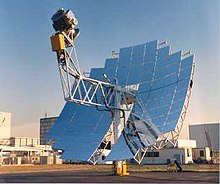
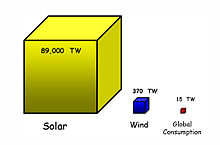
| Part of a series on |
| Renewable energy |
|---|
 |
Solar energy is energy from the sun. This renewable energy, predominantly in the form of light, supports life on Earth and drives the Earth's weather. Solar energy also broadly describes technologies that utilize sunlight.
The applications of solar energy date back millennia. The Greeks, Native Americans and Chinese warmed their buildings by orienting them toward the sun. In Europe, farmers used elaborate field orientation and thermal mass to increase crop yields during the Little Ice Age. Modern solar technologies continue to harness the sun to provide water heating, daylighting and even flight.[1][2]
Solar power generally describes technologies that convert sunlight into electricity and in some cases thermal or mechanical power. In 1866, the French engineer Auguste Mouchout successfully powered a steam engine with sunlight. This is the first known example of a solar powered mechanical device. Over the next 50 years inventors such as John Ericsson, Charles Tellier and Frank Shuman developed solar powered devices for irrigation, refrigeration and locomotion. The progeny of these early developments are concentrating solar power plants.[2]
The modern age of solar power arrived in 1954 when researchers at Bell Laboratories developed a photovoltaic cell capable of effectively converting light into electricity. This breakthrough marked a fundamental change in how power is generated. Since then solar cells efficiencies have improved from 6% to 15% with experimental cells reaching efficiencies over 40%. Prices on the other hand have fallen from $300 per watt to less than $3 per watt.[3]
The utilization of solar energy and solar power spans from traditional technologies that provide food, heat and light to electricity which is uniquely modern. Solar energy is used in a wide variety of applications, including:
- Heat (hot water, building heat, cooking, process heat)
- Lighting (daylighting, hybrid lighting, daylight savings time)
- Electricity generation (photovoltaics, heat engines)
- Transportation (solar car, solar plane, solar boat)
- Desalination
- Biomass (wood, biofuel)
- Clothes drying
Energy from the Sun

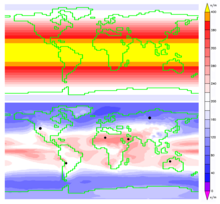
The Earth receives 174 petawatts (PW) of solar radiation at the upper atmosphere. While traveling through the atmosphere, 6% of the incoming solar radiation (insolation) is reflected and 16% is absorbed. Average atmospheric conditions (clouds, dust, pollutants) further reduce insolation by 20% through reflection and 3% through absorption. The absorption of solar energy by atmospheric convection (sensible heat transport) and by the evaporation and condensation of water vapor (latent heat transport) drive the winds and the water cycle.[4]
The atmosphere not only reduces the quantity of radiation reaching the Earth's surface, it also alters the spectrum of the radiation by a process described as diffuse insolation. [5] After passing through the Earth's atmosphere approximately half the insolation is in the visible electromagnetic spectrum with the other half mostly in the infrared spectrum, and a small part of ultraviolet radiation.[6] Upon reaching the surface, insolation is absorbed by the oceans, earth and plants. The energy captured in the oceans drives the thermohaline cycle. As such, solar energy is ultimately responsible for temperature driven ocean currents such as the thermohaline cycle and wind driven currents such as the Gulf Stream. The energy absorbed by the earth in conjunction with that recycled by the Greenhouse effect warms the surface to an average temperature of approximately 14°C.[7] The solar energy captured by plants and other phototrophs is converted to chemical energy via photosynthesis. All the food we eat, wood we build with, and fossil fuels we use are products of photosynthesis.[8]
The flows and stores of solar energy are vast in comparison to human energy needs.
- The total solar energy available to the earth is approximately 3850 zettajoules (ZJ) per year.[9]
- Oceans absorb approximately 285 ZJ of solar energy per year.
- Winds can theoretically supply 6 ZJ of energy per year.[10]
- Biomass captures approximately 1.8 ZJ of solar energy per year.[11][9]
- Worldwide energy consumption was 0.471 ZJ in 2004.[12]
The map on the right (top) shows how solar radiation at the top of the earth's atmosphere varies with latitude. The bottom map shows annual average ground level insolation. For example, in North America the average insolation at ground level over an entire year (including nights and periods of cloudy weather) lies between 125 and 375 W/m² (3 to 9 kWh/m²/day).[13] At present, photovoltaic panels typically convert about 15% of incident sunlight into electricity; therefore, a solar panel in the contiguous United States on average delivers 19 to 56 W/m² or 0.45 - 1.35 kWh/m²/day.[14]
Types of technologies
Many technologies use solar energy. Some classifications of solar technology are active, passive, direct and indirect.
- Active solar systems use electrical and mechanical components such as tracking mechanisms, pumps and fans to process sunlight into usable outputs such as heating, lighting or electricity.
- Passive solar systems use non-mechanical techniques of controlling, converting and distributing sunlight into usable outputs such as heating, lighting, cooling or ventilation. These techniques include selecting materials with favorable thermal properties, designing spaces that naturally circulate air, and referencing the position of a building to the sun.
- Direct solar generally refers to technologies or effects that involve a single conversion of sunlight which results in a usable form of energy.
- Indirect solar generally refers to technologies or effects that involves multiple transformations of sunlight which result in a usable form of energy.
Architecture and Urban planning
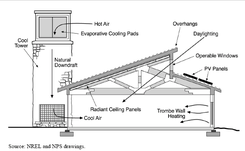
Solar architecture controls the use of the sun to provide comfortable temperatures, lighting and air quality. The basic elements of solar architecture are building orientation, proportion, thermal mass and window placement. The solar architecture and design process tailors these elements to the local climate and environment.
The oldest principle of solar architecture is building orientation. The entire building can be positioned and angled to be oriented towards or away from the sun, overshadowing from other structures or natural features can be avoided or used, and the building can be set into the ground using earth sheltering techniques.
- As a general rule, a solar building's axis should run lengthwise east to west and the structure should be twice as long as wide.
- Windows facing the equator should be equal to 5-7% of the building's floor space.[15] If heating is a concern, window area facing away from the equator should be minimized.
- The thermal mass in the building should be sized to smooth out temperature swings.
- Spaces can be designed to naturally circulate air. Cooling elements such as a solar chimney can be incorporated to help with ventillation.
- Lighting quality and energy use are strongly influenced by window design. In cold climates insulated glazing with low-emissivity coatings can maximize solar gain and reduce heat losses by 30-50%. In hot climates low-emissivity coatings on the outside of window panes can be used to reduce and control solar gain.[16]
- The albedo of an object indicates the percentage of light it reflects. Asphalt has an albedo of around 10% while the average albedo of the Earth is 30%.[17] Urban heat islands (UHI) are metropolitan areas with significantly higher temperatures than the surrounding environment. These higher temperatures are the result of urban materials such as concrete and asphalt which have lower albedos and higher heat capacities than the natural environment. A straightforward method of counteracting the UHI effect is to paint buildings and roads white and plant trees. A hypothetical "cool communities" program in Los Angeles, California called for the planting of ten million trees, the reroofing of almost 5 million homes and painting one-quarter of the roads. These measures are estimated to reduce urban temperatures by approximately 3°C. The projected costs of such a program are approximately $1 billion. The annual savings from reduced air-conditioning costs are estimated at $170 million with an additional yearly health benefit of $360 million in smog-reduction savings.[18][19]
Lighting
The history of lighting is dominated by the use of natural light. The Romans recognized the Right to Light as early as the 6th century and English law echoed these judgements with the Prescription Act of 1832. It wasn't until the 1900s that artificial lighting took over as the main source of interior illumination. The 1973 oil and 1979 energy crises brought attention to conservation measures such as natural lighting but interest waned on both occasions with the restoration of energy supplies. Approximately 20% of the electricity used in the United States is for lighting. When daylighting techniques are appropriately applied natural light can supply interior lighting for many hours of the day.[5]
Daylighting is a passive solar method of using sunlight to provide illumination. Daylighting directly offsets energy use in electric lighting systems and indirectly offsets energy use through a reduction in cooling load.[20] Although difficult to quantify, the use of natural lighting also offers physiological and psychological benefits compared to artificial lighting. Daylighting features include building orientation, window orientation, exterior shading, sawtooth roofs, clerestory windows, light shelves, skylights and light tubes.[21] These features may be incorporated in existing structures but are most effective when integrated in a solar design package which accounts for factors such as glare, heat gain, heat loss and time-of-use. Architectural trends increasingly recognize daylighting as a cornerstone of sustainable design.
Hybrid solar lighting (HSL) is an active solar method of using sunlight to provide illumination. Hybrid solar lighting systems collect sunlight using focusing mirrors that track the sun. The collected light is transmitted via optical fibers into a building's interior to supplement conventional lighting. In single story applications, these systems are able to transmit 50% of received direct sunlight.[5]
Daylight saving time (DST) utilizes solar energy by matching available sunlight to the time of the day in which it is most useful.
Joel JoelJoelJoelJoelJoelJoelJoelJoelJoeljoeljoeljoeljoeljoeljoeljoeljoeljoeljoeljoeljoel & liamliamliamliamliamliamliamliaml form norfolk iisland
Water heating
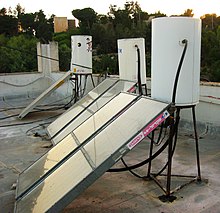
Solar hot water systems use sunlight to heat water. Commercial solar water heaters began appearing in the United States in the 1890s. These systems saw increasing use until the 1920s but were thereafter gradually replaced by relatively cheap and more reliable conventional heating fuels. The economic advantage of conventional heating fuels has varied over time resulting in periodic interest in solar hot water; however, solar hot water technologies have yet to show the sustained momentum they lost in the 1920s. That being said, the recent price spikes and erratic availability of conventional fuels is renewing interest in solar heating technologies.[2][22]
As of 2005, the total installed capacity of solar hot water systems is 88 GWth and growth is 14% per year.[23] China is the world leader in the deployment of solar hot water systems with 80% of the market.[24] Israel is the per capita leader in the use of solar hot water with 90% of homes using this technology.[23] In the United States heating swimming pools is the most successful application of solar hot water.[22]
Solar water heating is highly efficient (up to 86%) and is particularly appropriate for low temperature (25-65 °C) applications such as domestic hot water, heating swimming pools and space heating. The oldest and simplest type of solar water heater is a black water tank which is exposed to the sun. These are called batch systems but there are many other configurations. Some configurations are designed to heat water to high temperatures while other are designed for economy. [22]
A solar pond is a pool of salt water that collects and stores solar energy. Solar ponds were first proposed by Dr. Rudolph Bloch in 1948 after coming across reports of a lake in Hungary in which the temperature increased with depth. This effect was due to salts in the lake's waters which created a "density gradient" that prevented convection currents. A prototype was constructed in 1958 on the shores of the Dead Sea near Jerusalem.[25] The pond consisted of layers of water that successively increased from a weak salt solution at the top to a high salt solution at the bottom. This solar pond was capable of producing temperatures of 90 °C in its bottom layer and had an estimated solar to electric efficiency of 2%. Current, representatives of this technology include a 150 KW pond in En Boqeq, Israel, and another used for industrial process heat at the University of Texas El Paso.[26]
Heating, cooling and ventilation
- A thermal mass is a body that absorbs and holds heat. In the context of solar energy, it is a mass designed to store heat during sunny periods and release heat when sunlight levels are reduced or unavailable. A properly sized thermal mass will smooth out temperature swings and help keep rooms at a comfortable temperature throughout the day and night.
- A Trombe wall is a passive solar heating and ventilation system consisting of an air channel sandwiched between a window and a sun-facing thermal mass. During the ventilation cycle sunlight stores heat in the thermal mass and warms the air channel causing circulation through vents at the top and bottom of the wall. During the heating cycle the Trombe wall radiates stored heat.[27]
- A transpired collector is a perforated sun-facing wall. The wall absorbs sunlight and pre-heats air as much as 22°C as it is drawn into the ventilation system. These systems are highly efficient (up to 80%) and can pay for themselves within 3-12 years in offset heating costs.[28]
- Solar cooling can be achieved via absorption refrigeration cycles, desiccant cycles and solar mechanical processes. In 1878 Auguste Mouchout pioneered solar cooling by making ice using a solar steam engine attached to a refrigeration device.[2]
- A solar chimney (or thermal chimney) is a passive solar ventilation system composed of a hollow thermal mass connecting the inside and outside of a building. As the chimney warms the air inside is heated causing an updraft which enhances the natural stack ventilation through a building. These systems have been in use since Roman times and are common in the Middle east.
Photovoltaics

A solar cell or photovoltaic cell is a device that converts light into electricity using the photovoltaic effect. The first working solar cells were constructed by Charles Fritts in 1883. These prototype cells were made of selenium and achieved efficiencies of around 1%. Following the fundamental work of Russell Ohl in the 1940s, researchers Gerald Pearson, Calvin Fuller and Daryl Chapin created the silicon solar cell in 1954.[29]
Until recently, their use has been limited because of high manufacturing costs. One cost effective use has been in very low-power devices such as calculators with LCDs. Another use has been in remote applications such as roadside emergency telephones, remote sensing, cathodic protection of pipe lines, and limited "off grid" home power applications. A third use has been in powering orbiting satellites and spacecraft.
To take advantage of the incoming electromagnetic radiation from the sun, solar panels can be attached to each house or building. The panels should be mounted perpendicular to the arc of the sun to maximize usefulness. The easiest way to use this electricity is by connecting the solar panels to a grid tie inverter. However, these solar panels may also be used to charge batteries or other energy storage device. Solar panels produce more power during summer months because they receive more sunlight.
Total peak power of installed PV is around 6,000 MW as of the end of 2006. Installed PV is projected to increase to over 9,000 MW in 2007.[30][31]
Declining manufacturing costs (dropping at 3 to 5% a year in recent years) are expanding the range of cost-effective uses. The average lowest retail cost of a large photovoltaic array declined from $7.50 to $4 per watt between 1990 and 2005.[32] With many jurisdictions now giving tax and rebate incentives, solar electric power can now pay for itself in five to ten years in many places. "Grid-connected" systems - those systems that use an inverter to connect to the utility grid instead of relying on batteries - now make up the largest part of the market.
In 2003, worldwide production of solar cells increased by 32%.[33] Between 2000 and 2004, the increase in worldwide solar energy capacity was an annualized 60%.[34] 2005 was expected to see large growth again, but shortages of refined silicon have been hampering production worldwide since late 2004.[35] Analysts have predicted similar supply problems for 2006 and 2007.[36]
Solar power plants
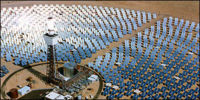
Solar power plants use a variety of methods to collect sunlight and convert this energy into electricity, distill water or provide heat for industrial processes. Concentrating solar thermal power plants have traditionally been the most common type of solar power plant; however, multi-megawatt photovoltaic sites have seen recent rapid deployment.
Concentrating Solar Thermal (CST) systems use lenses or mirrors and tracking systems to focus a large area of sunlight into a small beam. CST technologies require direct insolation to perform properly. This requirement makes them inappropriate for significantly overcast locations.[37]
The three basic CST technologies are the solar trough, solar power tower and parabolic dish. Each technology is capable of producing high temperatures and correspondingly high thermodynamic efficiencies but they vary in the way they track the sun and focus light.
- Line focus/Single-axis
- A solar trough consists of a linear parabolic reflector which concentrates light on a receiver positioned along the reflector's focal line. These systems use single-axis tracking to follow the sun. A working fluid (oil, water) flows through the receiver and is heated up to 400 °C before transferring its heat to a distillation or power generation system.[38].[39] Trough systems are the most developed CST technology. The Solar Electric Generating System (SEGS) plants in California and Plataforma Solar de Almería's SSPS-DCS plant in Spain are representatives of this technology.[38]
- Point focus/Dual-axis
- A power tower consists of an array of flat reflectors (heliostats) which concentrate light on a central receiver located on a tower. These systems use dual-axis tracking to follow the sun. A working fluid (air, water, molten salt) flows through the receiver where it is heated up to 1000 °C before transferring its heat to a power generation or energy storage system. Power towers are less advanced than trough systems but they offer higher efficiency and energy storage capability.[40] The Solar Two in Daggett, California and the Planta Solar 10 (PS10) in Sanlucar la Mayor, Spain are representatives of this technology.
- A parabolic dish or dish/engine system consists of a stand-alone parabolic reflector which concentrates light on a receiver positioned at the reflector's focal point. These systems use dual-axis tracking to follow the sun. A working fluid (hydrogen, helium, air, water) flows through the receiver where it is heated up to 1500 °C before transferring its heat to a sterling engine for power generation.[39][40] Parabolic dish systems display the highest solar-to-electric efficiency among CST technologies and their modular nature offers scalability. The Stirling Energy Systems (SES) and Science Applications International Corporation (SAIC) dishes at UNLV and the Big Dish in Canberra, Australia are representatives of this technology.
A solar updraft tower (also known as a solar chimney or solar tower) consists of a large greenhouse which funnels into a central tower. As sunlight shines on the greenhouse the air inside is heated and expands. The expanding air flows toward the central tower where a turbine converts the air flow into electricity. A 50 kW prototype was constructed in Ciudad Real, Spain and operated for eight years before decommissioning in 1989.[41]
Cooking

Solar cookers (or solar ovens) use sunlight for cooking, drying and pasteurization. Solar cookers offset fuel costs and reduce demand for local firewood. Solar cookers also improve local air quality by removing a source of smoke. The most common designs are box cookers, concentrating cookers and panel cookers.
- Solar box cookers consist of an insulated container with a transparent lid. Horace de Saussure developed this design in 1767 after observing: "It is a known fact, and a fact that has probably been known for a long time, that a room, a carriage, or any other place is hotter when the rays of the sun pass through glass." These cookers can be effectively used with partially overcast skies and can typically reach temperatures of 50-100°C. These are the cheapest and most widely used cooker design.[2][42]
- Concentrating solar cookers use a parabolic reflector to concentrate light on a container positioned at the reflector's focal point. These designs cook faster and at higher temperatures (up to 315°C). As with other concentrating technologies these cookers require direct light and must be repositioned to track the sun.[42]
- Solar Panel cookers (SPC) use flat reflectors to concentrate sunlight on a container within a transparent covering. Roger Bernard is credited with introducing panel cookers in 1994. This design uses partial concentration and will maintain effective operation with limited repositioning.
Solar chemical
Solar chemical processes convert solar energy into chemical energy. These processes use both light (photochemical) and heat (endothermic) to drive chemical, thermochemical or thermoelectric reactions. Solar chemical reactions can be used to store solar energy or replace energy that would otherwise be required from an alternate source.
Electrochemical cells, commonly known as batteries, convert electrical energy into chemical energy. Solar energy can indirectly be converted into chemical energy in a system involving a photovoltaic to electrochemical cell exchange. A more direct approach involves the use of photoelectrochemical cells which use light to produce hydrogen in a process similar to the electrolysis of water. A third approach involves the use of thermoelectic devices which convert a temperature difference between dissimilar metals into an electric current between those metals. This current can be use to produce hydrogen and oxygen through the electrolysis of water. The solar pioneer Mochout envisioned using the thermoelectric effect to store solar energy for later use during darkness; however, his experiments toward this end never progressed beyond primitive devices.[2]
Concentrating solar thermal technologies can be used to drive high temperature chemical processes.
- Ammonia can be decomposed into nitrogen and hydrogen at high temperatures (650-700°C). The stored gases can be subsequently recombined to generate heat or electricity via a fuel cell. A prototype system was constructed at the Australian National University.[43][44]
- Zinc Oxide (ZnO) can be decomposed at high temperatures (1200-1750°C). The resulting pure zinc can be marketed directly. Alternatively, the zinc can be reacted with water at (350°C) to produce ZnO and hydrogen.[45][46]
- Water can be directly dissociated at high temperatures (2300-2600°C). These process have so far been limited due to their high level of complexity and low solar to hydrogen efficiency (1-2%).[47] An alternate path of research is investigating solar thermochemical cycles that can be used to dissociate water at lower temperatures. Thermochemical cycles are currently at the prototype stage.[48][49]
- Concentrating solar thermal has also been investigated as a direct thermal method of producing aluminum.[50]
While not a technology, photosynthesis is arguably the most important photochemical interaction. A diverse biology has developed capable of photosynthesizing light in the visible, ultraviolet, near infrared and far infrared regions of the electromagnetic spectrum.
Salt evaporation ponds are shallow man-made ponds designed to extract salt from sea water. The seawater is fed into large ponds and water is drawn out through natural evaporation. After the sun and winds have evaporated the water the salt is harvested.
Solar vehicles
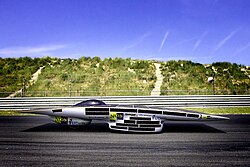

Development of a practical solar powered car has been an engineering goal for 20 years. The center of this development is the World Solar Challenge, a biannual solar powered car race over 3021 km (1877mi) through central Australia from Darwin to Adelaide. The race's stated objective is to promote research into solar-powered cars. Teams from universities and enterprises participate. In 1987 when it was founded, the winner's average speed was 67 km/h (42 mph).[51] By the 2005 race this had increased to an average speed of greater than 100 km/h (62 mph), even though the cars were faced with the 110 km/h (68 mph) South Australia speed limit.[52]
Helios, named after the Greek sun god of the same name, was a prototype solar powered unmanned aircraft. AeroVironment, Inc. developed the vehicle under NASA's Environmental Research Aircraft and Sensor Technology (ERAST) program.
On 13 August, 2001, it set an unofficial world record for sustained altitude by a winged aircraft. It sustained flight at above 96,000 feet (29,250 m) for forty minutes, and at one time it flew as high as 96,863 feet (29,524 m). Later, in June 2003, the prototype broke up and fell into the Pacific Ocean about ten miles (16 km) west of the Hawaiian Island Kauai.
The first practical solar boat was probably constructed in 1975 in England (see Electrical Review Vol 201 No 7 12 August 1977). By 1995 passenger boats began appearing and are now used extensively.[53] Solar powered boats have advanced sufficiently to cross the Atlantic. The first crossing of the Atlantic Ocean was achieved in the winter of 2006/2007 by the solar catamaran sun21.[54]
A solar balloon is a black balloon that is filled with air. As sunlight shines on the balloon the air inside is heated and expands. This causes an upward buoyancy force. As such, the balloon functions like a hot air balloon. Some solar balloons are large enough for human flight but usage at the moment is restricted to the toy market.
Desalination and disinfection

A solar still uses solar energy to distill water. A few basic types of solar stills are cone shaped, boxlike, and pit. For cone solar stills, impure water is inserted into the container, where it is evaporated by the sun through clear plastic. The pure water vapor condenses on top and drips down to the side, where it is collected and removed. The most sophisticated of these are the box shaped types. The least sophisticated are the pit types.
Solar water pasteurization uses solar energy to disinfect water. The basic pasteurization process consists of heating water up to 60-70°C and holding the temperature steady for a time period. The most heat resistant organisms will be rendered inert by a temperatures of 70° in ten minutes, 75°C in one minute, and 80°C in five seconds.[55][56]
Solar water disinfection (SODIS) is another method of disinfecting water using sunlight. The basic process involves filling a clear container 3/4 with water, shaking the container vigorously for 20 seconds, topping off the container and placing it in the sun. Shaking the container allows for the water to become aerated which encourages disinfection. As sunlight shines on the container the UV-A radiation causes the dissolved oxygen to become highly reactive. This reactive form of oxygen kills microorganism directly and interferes with the reproduction cycle of bacteria. As the container warms harmful organisms are also destroyed by heat treatment. Although endorsed by the World Health Organization, SODIS is not as effective as pasteurization and the completeness of disinfection is not easily measurable.[57][58][59]
Energy storage

Solar energy has traditionally been stored as heat in thermal storage systems or chemically in batteries. Solar energy has been experimentally stored thermochemically in phase change materials and at high temperatures using molten salts. The storage of excess solar energy allows for the availability of this energy during hours of darkness or cloud cover.
Thermal mass systems use various methods and materials (adobe, earth, concrete, water) to store solar energy for short or long durations (Seasonal thermal store). Thermal mass can be used to lower peak demand, shift time-of-use to off-peak hours and reduced overall heating and cooling requirements.
Solar energy can be stored thermochemically with phase change materials (PCM). Devices of this type which store latent heat can be thought of as heat batteries. Phase change materials are classified as organic (paraffins, fatty acids) and inorganic (salts, metals,alloys).[60]
- A Paraffin wax thermal storage system consists of a solar hot water loop connected to a paraffin wax tank. During the storage cycle, hot water flows through the storage tank melting the paraffin wax. The enthalpy of fusion for paraffin wax is 210-230 kJ/kg. During the heating cycle, stored heat is extracted from the tank as the wax resolidifies. These systems heat air and water up to 64°C and can reduce conventional energy use by 50%-70%.[61][60]
- Eutectic salts such as Glauber's salt can also be employed in thermal storage systems. Glauber's salt are relatively inexpensive and readily available and can store 347 kJ/kg and deliver heat at 64°C. The Dover house in Dover, Massachusetts was the first to use a Glauber's salt heating system in 1948.Cite error: A
<ref>tag is missing the closing</ref>(see the help page).
Solar energy can be stored at high temperatures using molten salts. Salts are an effective storage medium because they are non-flammable, non-toxic, low-cost, have a high specific heat capacity and can deliver heat at temperatures compatible with conventional power systems. A molten salt storage system consists of a salt loop connected to a insulated storage tank. During the heating cycle the salt mixture is heated from 290°C to 565°C. During the power cycle the salt is used to make steam for a steam-electric power plant. The Solar Two used this method of energy storage. The Solar Two could store 1.44 TJ (400,000 kWh) in its 68 m³ storage tank and had an annual storage efficiency of about 99%.[62]
Rechargeable batteries can be used to store excess electricity from a photovoltaic (PV) system. This type of storage system consists of a PV power source connected to a battery bank via a charge controller and inverter. Lead acid batteries are the most common type of battery associated with PV systems because of their relatively low upfront costs and high availability. Lead acid batteries have an energy density of 110-140 kJ/kg, a charge/discharge efficiency of 70-92% and cost $150-200 per kWh ($45-55 per MJ). Batteries used in off-grid applications should be sized for 3-5 days of capacity and should limit depth of discharge to 50% to minimize cycling and prolong battery life.[63]
Excess electricity from PV systems can also be sent to the transmission grid. This electricity can be used to fill existing demand or temporarily stored for later use. Net metering (Grid-tied electrical system) policies give PV system owners a credit for the electricity they deliver to the grid. This credit is used to off-set electricity provided from the grid when the PV system cannot fill demand.
Solar power by country
- See the articles for individual countries listed at Category:Solar power by country
Development, deployment and economics
Solar energy is in general not economically competitive compared to fossil fuels. Other than market forces, solar industry needs government sponsorship to help generate enough momentum in the solar market. The following trends are a few examples by which the solar market is being helped to attain critical mass so that it becomes competitively sustainable :
- Government grants for research in solar technology to make the production cheaper and generation more efficient.[64]
- Many countries and states have implemented incentives to encourage consumers to consider solar power. Examples include government tax subsidies, partial copayment schemes and various rebates over purchase costs of solar devices. These are meant to relieve some pressure off the consumer and entice them not to fear the high initial deployment investments.[65]
- Adoption of an energy policy where the consumer can connect their local solar power generators to the local grid, and reverse feed the grid with the unconsumed extra power. The state power authority guarantees an attractive purchase price for the power that is reverse metered. This has been especially popular in Germany and Japan.[66]
- Development of solar loan programs, with attractive return rates, to buffer the initial deployment costs and entice consumers to consider and purchase solar PV systems. The most famous example is the solar loan program sponsored by UNEP helping 100000 people finance solar power systems in India.[67] Success in India's solar program has led to similar projects in other parts of developing world like Tunisia, Morocco, Indonesia and Mexico.
Photovoltaics is gaining credence among private investors as having the potential to grow into the next big industry. Many companies and venture capitalists are investing in photovoltaic development and manufacturing. This trend is particularly visible in Silicon valley, California.[68][69][70] Nanotechnology manufacturing using CIGS solar cells promises to produce electricity at a cost of around 5¢/kwh and sell for $ 0.36 per peak watt,[71] approximately 10 times less than average 2007 prices for solar panels.[72]
Deployment of solar power depends largely upon local conditions and requirements. All industrialised nations share a need for electricity and it is believed that solar power will increasingly be used as an option for electricity supply. The Very Large Scale Photovoltaic Power Generation (VLS-PV) proposal argues that "PV systems could generate many times the current primary global energy supply".[73] To compensate for night time energy demands they would need to be complemented with pumped storage.
Solar energy associations
- ISES: International Solar Energy Society International NGO supporting renewable and sustainable technologies.
- ASES: American Solar Energy Association US organization supporting solar energy, efficiency and sustainable technologies.
- SEIA: Solar Energy Industries Association US trade association of solar energy manufacturers, dealers, distributors, contractors
- Canadian Solar industry Association
- ESTIF - European Solar Thermal Industry Federation
- See also: Photovoltiac Industry Associations
Solar energy research institutes
There are many research institutions and departments at universities around the world who are active in solar energy research. Countries which are particularly active include Germany, Spain, Japan, Israel, Australia, China, and the USA.
- National Renewable Energy Laboratory NREL
- Centre for Renewable Energy Systems Technology, at Loughborough University
- Centre for Sustainable Energy Systems at the Australian National University
- Florida Solar Energy Center
- Solar Energy Laboratory at UW Madison
- See also: Photovoltaics research institutes
See also
- 1973 energy crisis
- Absorption (electromagnetic radiation)
- COMES, French Solar Energy Authority
- Deployment of solar power to energy grids
- Energy crisis
- Energy development
- Energy storage
- Energy: world resources and consumption
- European Union Climate Change Programme
- Future energy development
- Green electricity
- Global dimming
- insolation
- List of conservation topics
- Microgeneration
- Photoelectric effect
- Photovoltaics
- Renewable energy
- Solar air conditioning
- Solar balloon
- Solar car
- Solar cell
- insolation)
- Solar heating
- Solar gain
- Solar ponds
- Solar power plants in the Mojave Desert
- Solar power satellite
- Solar power tower
- Solar radiation
- Solar thermal energy
- Solar tracker
- Solar updraft tower
- Sustainable design
- Timeline of solar energy
- Trans-Mediterranean Renewable Energy Cooperation (TREC)
References
- ^ "The History of Solar" (PDF). United States Department of Energy. Retrieved 2007-09-29.
- ^ a b c d e f Perlin, John (1981). A Golden Thread (2500 Years of Solar Architecture and Technology). Van Nostrand Reinhold.
{{cite book}}: Unknown parameter|coauthors=ignored (|author=suggested) (help) - ^ Perlin, John. "Making Electricity Directly from Sunlight". California Solar Center. Retrieved 2007-09-29.
- ^ "Earth Radiation Budget". NASA Langley Research Center. 2006-10-17. Retrieved 2007-09-29.
- ^ a b c Muhs, Jeff. "Design and Analysis of Hybrid Solar Lighting and Full-Spectrum Solar Energy Systems" (PDF). Oak Ridge National Laboratory. Retrieved 2007-09-29.
- ^ "Natural Forcing of the Climate System". Intergovernmental Panel on Climate Change. Retrieved 2007-09-29.
- ^ Somerville, Richard. "Historical Overview of Climate Change Science" (PDF). Intergovernmental Panel on Climate Change. Retrieved 2007-09-29.
- ^ Vermass, Wim. "An Introduction to Photosynthesis and Its Applications". Arizona State University. Retrieved 2007-09-29.
- ^ a b Smil, Vaclav (2006-05-17). "Energy at the Crossroads" (PDF). Organisation for Economic Co-operation and Development. Retrieved 2007-09-29.
- ^ "Wind Energy Potential". American Wind Energy Association. Retrieved 2007-09-29.
- ^ Whittaker, Robert (1975). Primary Productivity of the Biosphere. Springer-Verlag. pp. 305–328.
{{cite book}}: Unknown parameter|coauthors=ignored (|author=suggested) (help) - ^ "International Energy Outlook 2007". Energy Information Administration. 2007-05. Retrieved 2007-09-29.
{{cite web}}: Check date values in:|date=(help) - ^ "Dynamic Maps, GIS Data, and Analysis Tools - Solar Maps". National Renewable Energy Laboratory. Retrieved 2007-09-29.
- ^ "PV Solar Radiation (Flat Plate, Facing South, Latitude Tilt)". National Renewable Energy Laboratory. Retrieved 2007-09-29.
- ^ Kriescher, Paul (2006-07-10). "A Solar Ready Home from an Energy Rater's Perspective" (PDF). Lightly Treading, Inc. Retrieved 2007-09-29.
- ^ "Low-emissivity Window Glazing or Glass". United States Department of Energy. Retrieved 2007-09-29.
- ^ Markvart, Tom (2003). Practical Handbook of Photovoltaics: Fundamentals and Applications. Elsevier Advanced Technology.
{{cite book}}: Unknown parameter|coauthors=ignored (|author=suggested) (help) - ^ Rosenfeld, Arthur. "Painting the Town White -- and Green". Heat Island Group. Retrieved 2007-09-29.
{{cite web}}: Unknown parameter|coauthors=ignored (|author=suggested) (help) - ^ Lomborg, Bjorn (2007). Cool It (The Skeptical Environmentalist's Guide to Global Warming). Knopf Publishing Group. pp. 21, 171.
- ^ Maxwell, Gregory. "Daylighting – HVAC Interaction Tests for the Empirical Validation of Building Energy Analysis Tools" (PDF). International Energy Agency. p. 85. Retrieved 2007-09-29.
{{cite web}}: Unknown parameter|coauthor=ignored (|author=suggested) (help) - ^ "Daylighting..." United States Department of Energy. Retrieved 2007-09-29.
- ^ a b c Perlin, John. "Solar Hot Water Heating". California Solar Center. Retrieved 2007-09-29.
- ^ a b Del Chiaro, Bernadette. "Solar Water Heating (How California Can Reduce Its Dependence on Natural Gas)" (PDF). Environment California Research and Policy Center. Retrieved 2007-09-29.
{{cite web}}: Unknown parameter|coauthor=ignored (|author=suggested) (help) - ^ Li, Ling (2007-05-08). "China to Push Use of Solar Water Heaters". Worldwatch Institute. Retrieved 2007-09-29.
- ^ Halacy, Daniel (1973). The Coming Age of Solar Energy. Harper and Row.
- ^ "Israel's 150 kW Solar Pond". Mother Earth News. May/June 1980. Retrieved 2007-09-29.
{{cite news}}: Check date values in:|date=(help) - ^ "Indirect Gain (Trombe Walls)". United States Department of Energy. Retrieved 2007-09-29.
- ^ "Solar Buildings (Transpired Air Collectors - Ventilation Preheating" (PDF). National Renewable Energy Laboratory. Retrieved 2007-09-29.
- ^ Perlin, John. "Photovoltaics". California Solar Center. Retrieved 2007-09-29.
- ^ "Solar Wave - April 2007 Edition" (PDF). Merrill Lynch. April 2007. Retrieved 2007-09-30.
- ^ "Installed PV power as of the end of 2005 in reporting IEA PVPS countries". International Energy Agency. Retrieved 2007-09-30.
- ^ "Solar Energy". Regional-Renewables. Retrieved 2007-09-30.
- ^ Jiménez, Viviana. "World Sales of Solar Cells Jump 32 Percent". Earth Policy Institute. Retrieved 2007-09-30.
- ^ Flannery, Russell (2006-03-27). "Sun King". Forbes. Retrieved 2007-09-30.
- ^ Gartner, John (2005-05-28). "Silicon Shortage Stalls Solar". Wired. Retrieved 2007-09-30.
- ^ Pichel, Jesse (2006-01-11). "2005 Solar Year-end Review & 2006 Solar Industry Forecast Polysilicon Supply Constraint Limiting Industry Growth". Piper Jaffray. Retrieved 2007-09-30.
{{cite news}}: Unknown parameter|coauthor=ignored (|author=suggested) (help) - ^ "Light and the PV Cell". United States Department of Energy. Retrieved 2007-09-30.
- ^ a b "Linear-focusing Concentrator Facilities: DCS, DISS, EUROTROUGH and LS3". Plataforma Solar de Almería. Retrieved 2007-09-29.
- ^ a b "CSP Technologies Overview". United States Department of Energy. Retrieved 2007-09-30.
- ^ a b "Solar thermal power plants - Technology Fundamentals". Renewable Energy World. Retrieved 2007-09-29.
- ^ Mills, David (2004). "Advances in solar thermal electricity technology". Solar Energy. 76 (1–3): 19–31. doi:10.1016/S0038-092X(03)00102-6.
- ^ a b "Design of Solar Cookers". Arizona Solar Center. Retrieved 2007-09-30.
- ^ Lovegrove, Keith (2004). "Developing Ammonia Based Thermochemical Energy Storage for Dish Power Plants" (PDF). Solar Energy. 76: 331–337.
{{cite journal}}: Unknown parameter|coauthor=ignored (|author=suggested) (help) - ^ Thomas, George. "Potential Roles of Ammonia in a Hydrogen Economy" (PDF).
{{cite web}}: Unknown parameter|coauthor=ignored (|author=suggested) (help) - ^ "Solar thermal ZnO-decomposition". Paul Scherrer Institut.
- ^ Genuth, Iddo (2005-09-09). "Zinc Powder Will Drive Your Hydrogen Car". IsraCast.
{{cite news}}:|access-date=requires|url=(help); Unknown parameter|coauthor=ignored (|author=suggested) (help); Unknown parameter|http://www.isracast.com/Articles/Article.aspx?ID=ignored (help) - ^ Pyle, Walter. "Direct Solar-Thermal Hydrogen Production from Water Using Nozzle/Skimmer and Glow Discharge". Retrieved 2007-09-30.
{{cite web}}: Unknown parameter|coauthor=ignored (|author=suggested) (help) - ^ "Fundamentals of a Solar-thermal Mn2O3/MnO Thermochemical Cycleto Split Water" (PDF). Retrieved 2007-09-30.
- ^ Allen, Ray. "Thermochemical Cycles and the Hydrogen Economy" (PDF). The University of Sheffield. Retrieved 2007-09-30.
{{cite web}}: Unknown parameter|coauthor=ignored (|author=suggested) (help) - ^ Murray, Jean (August 1995). "Investigation of Opportunities for High-Temperature Solar Energy in the Aluminum Industry" (PDF). National Renewable Energy Laboratory. Retrieved 2007-09-30.
- ^ "History of World Solar Challenge". Panasonic World Solar Challenge. Retrieved 2007-09-30.
- ^ "History of World Solar Challenge (2005)". Panasonic World Solar Challenge. Retrieved 2007-09-30.
- ^ Schmidt, Theodor. "Solar Ships for the new Millennium". TO Engineering. Retrieved 2007-09-30.
- ^ "The sun21 completes the first transatlantic crossing with a solar powered boat". Transatlantic 21. Retrieved 2007-09-30.
- ^ "Solar Water Pasturization". Retrieved 2007-09-30.
- ^ "A Summary of Water Pasteurization Techniques". Retrieved 2007-09-30.
- ^ Jagadeesh, Anumakonda. "Drinking Water For All" (PDF). Retrieved 2007-09-30.
- ^ Acra, A. "Water Disinfection by Solar Radiation". Retrieved 2007-09-30.
{{cite web}}: Unknown parameter|coauthor=ignored (|author=suggested) (help) - ^ "Water pasteurization". Retrieved 2007-09-30.
- ^ a b Gok, Özgül. "Stabilization of Glauber's Salt for Latent Heat Storage" (PDF). Çukurova University. Retrieved 2007-09-30.
{{cite web}}: Unknown parameter|coauthor=ignored (|author=suggested) (help) - ^ Romanowicz, Goska (2006-05-19). "Heat 'batteries' dramatically cut energy use". edie newsroom. Retrieved 2007-09-29.
{{cite news}}: Check|url=value (help) - ^ "Advantages of Using Molten Salt". Sandia National Laboratory. Retrieved 2007-09-29.
- ^ "Batteries". DC Power Systems. Retrieved 2007-09-29.
- ^ Carlstrom, Paul (2005-07-11). "As solar gets smaller, its future gets brighter (Nanotechnology could turn rooftops into a sea of power-generating stations)". SFGate. Retrieved 2007-09-30.
- ^ "California Formally Adopts Performance-Based Solar Incentives". Renewable Energy Access. 2006-08-29. Retrieved 2007-09-30.
- ^ Wolcott,Barbara (2001). "Solar Gains". The American Society of Mechanical Engineers. Retrieved 2007-09-30.
- ^ "UNEPs India Solar Loan Programme Wins Prestigious Energy Globe". United Nations Environment Programme. 2007-04-12. Retrieved 2007-09-30.
- ^ "Solar power shines bright in Silicon Valley". MSNBC. 2006-09-19. Retrieved 2007-09-30.
- ^ Rooney, Brian (2007-04-07). "Valley Betting on Solar Power". ABC News. Retrieved 2007-09-30.
- ^ Marshall, Matt (2004-08-15). "World events spark interest in solar cell energy start-ups". Mercury News. Retrieved 2007-09-30.
- ^ Sachitanand, N. N. "Breakthrough in solar photovoltaics". The Hindu. Retrieved 2007-09-30.
- ^ "Photovoltaic Module Survey Retail Prices (Dec 2001-Sept 2007)". Solarbuzz. Retrieved 2007-09-30.
- ^ Kurokawa, K. (December 2006). "Summary Energy from the Desert (Practical Proposals for Very Large Scale Photovoltaic Power Generation (VLS-PV) Systems)". International Energy Agency. Retrieved 2007-09-30.
{{cite news}}: Unknown parameter|coauthor=ignored (|author=suggested) (help)
External links
- White Paper Discussing the use of Carbon Finance to Develop Solar Power.
- Florida Solar Innovators.
- Scientific calculation of sun exposure. (in French)
- Solar Power-Renewable energy resource.
